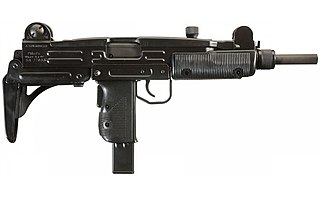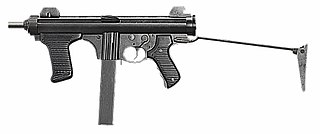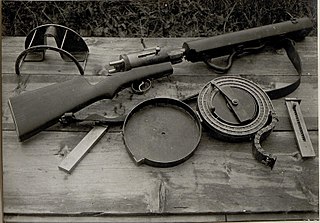
A submachine gun (SMG) is a magazine-fed automatic carbine designed to fire handgun cartridges. The term "submachine gun" was coined by John T. Thompson, the inventor of the Thompson submachine gun, to describe its design concept as an automatic firearm with notably less firepower than a machine gun. As a machine gun must fire rifle cartridges to be classified as such, submachine guns are not considered machine guns.

The Uzi is a family of Israeli open-bolt, blowback-operated submachine guns and machine pistols first designed by Major Uziel "Uzi" Gal in the late 1940s, shortly after the establishment of the State of Israel. It is one of the first weapons to incorporate a telescoping bolt design, which allows the magazine to be housed in the pistol grip for a shorter weapon.

The Thompson submachine gun is a blowback-operated, selective-fire submachine gun, invented and developed by United States Army Brigadier General John T. Thompson in 1918. It was designed to break the stalemate of trench warfare of World War I, although early models did not arrive in time for actual combat.

The STEN is a British submachine gun chambered in 9×19mm which was used extensively by British and Commonwealth forces throughout World War II and during the Korean War. The Sten paired a simple design with a low production cost, facilitating mass production to meet the demand for submachine guns.

The .45 Reising submachine gun was manufactured by Harrington & Richardson (H&R) Arms Company in Worcester, Massachusetts, USA, and was designed and patented by Eugene Reising in 1940. The three versions of the weapon were the Model 50, the folding stock Model 55, and the semiautomatic Model 60 rifle. Over 100,000 Reisings were ordered during World War II, and were initially used by the United States Navy, Marine Corps, and the United States Coast Guard, though some were shipped to Canadian, Soviet, and other allied forces to fight the Axis powers.

A firearm is said to fire from an open bolt or open breech if, when ready to fire, the bolt and working parts are held to the rear of the receiver, with no round in the chamber. When the trigger is actuated, the bolt travels forward, feeds a cartridge from the magazine or belt into the chamber, and fires that cartridge in the same movement. Like any other self-loading design, the action is cycled by the energy released from the propellant, which sends the bolt back to the rear, compressing the mainspring in readiness for firing the next round. In an open-bolt gun firing semi-automatically, the bolt is caught and held at this point by the sear after each shot; and in automatic open-bolt fire, it's caught and held in this manner whenever the trigger is released. In contrast to this, in closed-bolt guns, the trigger and sear do not affect the movement of the bolt directly.

The MP 18 is a German submachine gun designed and manufactured by Bergmann Waffenfabrik. Introduced into service in 1918 by the German Army during World War I, the MP 18 was intended for use by the Sturmtruppen, assault groups specialized in trench combat, as a short-range offensive weapon that would provide individual soldiers with increased firepower over a pistol.

The Type 100 submachine gun was a Japanese submachine gun used during World War II and the only submachine gun produced by Japan in any quantity. It was made in two basic variants referred to by American and British observers as the Type 100/40 and the Type 100/44, the latter also known as the Type 100 (simplified). A small number of the earlier version were converted into using folding stock, sometimes referred to by the Allies as the Type 100 navy, which was made for parachutists.

The Beretta M12 is a 9×19mm Parabellum caliber submachine gun designed by Beretta. Production started in 1959, the first users were the Italian Carabinieri, Italian State Police and the Guardia di Finanza, though in limited numbers; it was only widely issued beginning in 1978, replacing the old Beretta MAB. In 1962 the Italian Army bought a limited number of Franchi LF-57 submachine guns, judged better than the M12 but never issued to the troops, and only in 1992 the M12S2 variant was introduced, in very limited numbers. The Italian Air Force bought instead many M12S and M12S2 for the airport security units. However, the weapon had a higher initial success in the Arab countries and South America.

The Jatimatic is a Finnish 9×19mm Parabellum submachine gun developed in the late 1970s and early 1980s by Jali Timari. The submachine gun made its debut in 1983. The Jatimatic was manufactured in very limited numbers initially by Tampereen Asepaja Oy of Tampere and later—Oy Golden Gun Ltd. The firearm was designed primarily for police, security forces and armored vehicle crews. It was never adopted into service by the Finnish Defence Forces, although the later GG-95 PDW version was tested by the FDF in the 1990s.

The Smith & Wesson M76 submachine gun (SMG) was produced by Smith & Wesson from 1967 to 1974.

The name Borz is an umbrella term applied to all improvised submachine guns produced during the years of independence of the Chechen Republic of Ichkeria. It was produced in small numbers from 1992 to 1999. The initial model was based on the Armenian K6-92, which in turn was based on the PPS submachine gun.

The M3 is an American .45-caliber submachine gun adopted by the U.S. Army on 12 December 1942, as the United States Submachine Gun, Cal. .45, M3. The M3 was chambered for the same .45 ACP round fired by the Thompson submachine gun, but was cheaper to mass produce and lighter, at the expense of accuracy. The M3 was commonly referred to as the "Grease Gun" or simply "the Greaser," owing to its visual similarity to the mechanic's tool.

The Tokarev Model 1927 submachine gun was an experimental firearm developed in the Soviet Union under the leadership of Fedor Vasilievich Tokarev as part of the Soviet Union's drive to be self sufficient in armaments. It was a blowback-operated, two trigger weapon which fired a 7.62 mm round originally intended as a revolver round.
The Uru is a submachine gun made by the production firm Mekanika in 1977 for the Brazilian Army and Police Forces. License for weapons in 1988, bought the branch of FAU, which modernized the Thompson submachine gun in model 2. SACO Defense of the US manufactured the Uru as the Model 683 for countries without an industrial basis but were sued for copyright violations.

Auto-Ordnance was a U.S. arms development firm founded by retired Colonel John T. Thompson of the United States Army Ordnance Department in 1916. Auto-Ordnance is best known for the Thompson submachine gun, used as a military weapon by the Allied forces in World War II, and also notorious as a gangster weapon used during the Roaring Twenties.

The PPS is a family of Soviet submachine guns chambered in 7.62×25mm Tokarev, developed by Alexei Sudayev as a low-cost personal defense weapon for reconnaissance units, vehicle crews and support service personnel.

The Lmg.-Pistole Mod. 1941/44 – also known as Furrer MP 41/44, MP41/44 and LMG-Pistole – was the first submachine gun manufactured in Switzerland for the Swiss Army. The weapon used a complicated toggle-operated short recoil mechanism for its operation and it corresponds to that of the Furrer M25, which is why it is also called Lmg.-Pistole.

The Standschütze Hellriegel 1915 was an Austro-Hungarian water-cooled submachine gun produced during World War I in very limited prototype numbers.
Adolf Furrer was a Swiss military officer and small arms designer. He used to be the director of the Waffenfabrik Bern and held the rank of Oberstbrigadier in the Swiss Army.
















